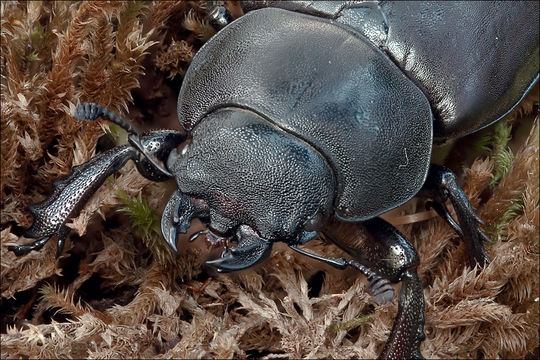歐洲深山鍬形蟲的圖片

描述:
Slo.: roga, kleman - Habitat: grassland, pasture, near mixed woods with Fagus sylvatica, Ostrya carpinifolia and Picea abies dominant trees; poorly maintained forest; locally flat terrain, colluvial, skeletal, calcareous ground; relatively warm place, in shade; elevation 600 m (1.970 feet); average precipitations ~ 3.000 mm/year, average temperature 7-9 deg C, alpine phytogeographical region. Comment: Lucanus cervus is Central and South European species. It is probably the most attractive beetle of Europe. It can reach up to 8 cm in length. The male's huge 'jaws' (antlers, mandibles) give it a fierce appearance. In reality the mandibles are too weak to seriously injure one's finger. They are used in courtship displays and wrestling with other males much like with deer. Much more 'dangerous' are female's jaws in spite of the fact that they are much smaller (biological dimorphism). They can indeed inflict a painful bite. The larvae of the stag beetle live within rotting logs very long - up to five years before pupating. Contrary, pupas and adults live much shorter time, from a few weeks to few months only. The natural reaction of the beetle to an approach is to remain motionless. Hence they are benevolent objects for photographers. When I was young, spending my holidays in Bohinj Mountains of Julian Alps, I was seeing several stag beetles every year. Now before this find I haven't see it for last six or seven years. The population of this beetle is shrinking drastically in many places. It is already extinct in Denmark. Registered in the second appendix of the Habitats Directive of the European Union from 1992. The species is also registered in the third appendix of the Convention on the Conservation of European Wildlife and Natural Habitats (Berne convention) of 1982. Pravilnik o uvrstitvi ogroenih rastlinskih in ivalskih vrst v rdei seznam, Uradni list RS, t. 82/2002 (Regulation of enlisting of endangered plant and animal species onto Red List, Official Gazette of Republic Slovenia, no. 82/2002) (2002). Ref.: (1) H.Garms, L. Borm, Fauna Europas, Georg Westermann Verlag (1977), translated to Slovenian; ivalstvo Evrope, Mladinska Knjiga (1981), p 382. (2) http://www.kerbtier.de/Pages/Themenseiten/enHirschkaefer.html (3) http://www.natura2000.si/uploads/tx_library/Priloga_5a_1351_bionomics_and_distribution_01.pdf
包含在以下頁面:
- Life
- Cellular
- Eukaryota (真核生物)
- Opisthokonta
- Metazoa
- Bilateria
- Protostomia
- Ecdysozoa (蜕皮动物总门)
- Arthropoda (節肢動物)
- Pancrustacea
- Hexapoda (六足亞門)
- Insecta (昆蟲)
- Pterygota (有翅亞綱)
- Neoptera (新翅下纲)
- Endopterygota
- Coleoptera (鞘翅目)
- Polyphaga
- Scarabaeiformia (金龟下目)
- Scarabaeoidea (金龜子總科)
- Lucanidae (鍬形蟲科)
- Lucanus (深山鍬形蟲屬)
- Lucanus cervus (歐洲深山鍬形蟲)
此圖片未被精選在任何收藏裡。
來源資訊
- 許可
- cc-by-nc-sa-3.0
- 版權
- 2016 Dr. Amadej Trnkoczy


